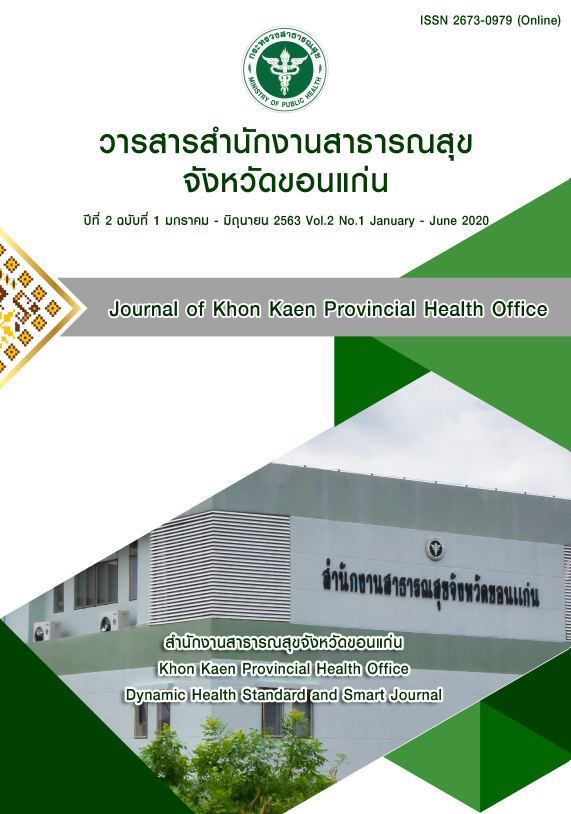การสร้างเสริมคุณภาพชีวิตครอบครัวที่มีบุคคลออทิสติก ในจังหวัดขอนแก่น ด้วยโปรแกรมฝึกทักษะสังคม
คำสำคัญ:
คุณภาพชีวิตครอบครัว, โปรแกรมฝึกทักษะสังคม, ออทิสติกบทคัดย่อ
ครอบครัวที่มีคนพิการได้รับผลกระทบต่อคุณภาพชีวิต โดยเฉพาะครอบครัวบุคคลออทิสติกวัยรุ่นซึ่งต้องการมีปฏิสัมพันธ์สังคมตามวัย และการพัฒนาทักษะสังคมต้องอาศัยครอบครัวเป็นหลัก งานวิจัยนี้จึงมีวัตถุประสงค์เพื่อเสริมสร้างคุณภาพชีวิตครอบครัวด้วยโปรแกรมฝึกทักษะสังคม ใช้การวิจัยกึ่งทดลอง ซึ่งเป็นส่วนหนึ่งของงานที่เสร็จสมบูรณ์ เครื่องมือประกอบด้วย แบบวัดคุณภาพชีวิตครอบครัวจำนวน 30 ข้อ มีค่าความเชื่อมั่น 0.93 และโปรแกรมฝึกทักษะสังคมที่ผู้วิจัยพัฒนาขึ้น ประกอบด้วย 1) ความรู้พื้นฐานเกี่ยวกับออทิซึม 2) ทักษะพ่อแม่ 3) ทักษะสังคมเรื่องวินัยที่บ้าน 4) ทักษะสังคมเรื่องการจัดการตนเองเมื่อโกรธ 5) ทักษะสังคมเรื่องการเข้าหาเพื่อน และ 6) เรื่องเล่าทางสังคม กลุ่มตัวอย่างได้แก่ครอบครัวที่มีบุคคลออทิสติกอายุ 12 -20 ปี จำนวน 52 ครอบครัว ผู้วิจัยแจกแบบวัดคุณภาพชีวิตครอบครัวให้ตอบ และคัดเลือกผู้มีคะแนนต่ำสุดเข้าเป็นกลุ่มตัวอย่าง 10 คน และกลุ่มเปรียบเทียบ 10 คน โดยกลุ่มตัวอย่างจะได้รับการอบรม 6 สัปดาห์ ๆ ละ 3 ชั่วโมง ร่วมกับการติดตามโดยการส่งการบ้าน และการเยี่ยมบ้าน ผลการศึกษา พบว่า คุณภาพชีวิตครอบครัวที่มีบุคคลออทิสติก ระยะก่อนได้รับโปรแกรม ในกลุ่มทดลองและกลุ่มเปรียบเทียบมีคะแนนไม่แตกต่างกัน ระยะหลังได้รับโปรแกรมพบว่า คะแนนคุณภาพชีวิตครอบครัวกลุ่มทดลองสูงกว่ากลุ่มเปรียบเทียบ (p=0.026) โดยพบว่า คะแนนคุณภาพชีวิตครอบครัวในกลุ่มทดลอง หลังได้รับโปรแกรมมีคะแนนเฉลี่ยสูงขึ้นทั้งโดยรวมและรายองค์ประกอบ (p <0.001) ดังนี้ ด้านสัมพันธภาพในครอบครัวมีความต่างของค่าเฉลี่ยสูงสุด (9.58) รองลงมาคือด้านการเลี้ยงดูบุตรในครอบครัว (8.06) ด้านการสนับสนุนทางสังคมและอารมณ์ (7.90) ด้านสุขภาพความเป็นอยู่ (6.00) และด้านข่าวสารสวัสดิการที่ได้รับ (5.00)
เอกสารอ้างอิง
Baio J, Wiggins L, Christensen DL, et al. Prevalence of Autism Spectrum Disorder Among Children Aged 8 Years-Autism and Developmental Disabilities Monitoring Network, 11 Sites, United States, 2014. MMWR Surveill Summ. 2018; 67 (No. SS-6): 1–23. DOI: http://dx.doi.org/10.15585 /mmwr.ss6706a1.
Gray DE. Coping over time: the parents of children with autism. J Intellect Disabil Res. 2006; 50(12): 970-976. https:// doi.org/10.1111/j.1365-2788.2006.00 933.x.
Shimabukuro TT, Grosse SD, Rice C. (2008). Medical expenditures for children with an autism spectrum disorder in a privately insured population. J Autism Dev Disord. 2008 Mar; 38(3): 546-52. Epub 2007 Aug 10.
Benjak T. Subjective quality of life for parents of children with autism spectrum disorders in Croatia. Applied Research Quality Life. 2011; 6: 91–102. DOI 10.1007/s11482-010-9114-6.
Werner S, Edwards M, & Baum NT. Family quality of life before and after out-of-home placement of a family member with an intellectual disability. Journal of Policy and Practice in Intellectual Disabilities 2009; 6: 32–39.
Brown RI, Geider S, Primrose A & Jokinen NS. Family life and the impact of previous and present residential and day care support for children with major cognitive and behavioural challenges: a dilemma for services and policy. Journal of Intellectual Disability Research. 2011; 55(9): 904-917.
Isaacs BJ, Brown I, Brown RI, Baum N, Myerscough T, Neikrug S, et al. The international family quality of life project: Goals and description of a survey tool. Journal of Policy and Practice in Intellectual Disabilities. 2007; 4: 177–185.
Schalock R, Brown I, Brown RI, Cummins R, Felce D, Matikka L, et al. Conceptualization, measurement, and application of quality of life for persons with intellectual disabilities: Report of an international panel of experts. Mental Retardation. 2002; 40: 457-470.
Maneerat T, Jongudomkarn D, & Khiewyoo J. Development of family quality of life scale for Thai families who have persons with disabilities. Journal of Nursing Science and Health [Internet]. 2014; 37(4): 13-6. Available from: https://www.tci-thaijo. org/index.php/nah/article/view/23949.
Hoffman L, Marquis J, Poston D, Summers JA, & Turnbull A. Assessing family outcomes: Psychometric evaluation of the Beach Center Family Quality of Life Scale. Journal of Marriage and Family. 2006; 68: 1069–1083.
Keen D. Parents, families and partnerships: issues and considerations. International Journal of Disability Development and Education. 2007; 54(3): 339-349.
Friedman MM. Family nursing theory and assessment. (2nd e.d.) 1986 Connecticutt : Appleton-Century-Crofts.
พัฒนาสังคมและความมั่นคงของมนุษย์จังหวัดขอนแก่น. แผนพัฒนาคุณภาพชีวิตคนพิการจังหวัดขอนแก่น ฉบับที่ 3 พ.ศ. 2560–2564 (แผนปฏิบัติการภายใต้แผนพัฒนาคุณภาพชีวิตคนพิการแห่งชาติฉบับที่ 5 พ.ศ.2560–2564) 2560. เอกสารอัดสำเนา.
Carr EG, Dunlap G, Horner RH, Koegel RH, Turnbull AP, Sailor W, & Fox L. Positive behavior support: Evolution of an applied science. Journal of Positive Behavior Interventions. 2002; 4: 4-16. [Ref list]
Dunlap G, Strain PS, Lee JK, Joseph JD, Vatland C, & Fox L. Prevent Teach - Reinforce for Families: A model of individualised positive behavior support for home and community. 2017; Baltimore, ML: Paul H. Brookes Publishing Co.
เพ็ญนภา กุลนภาดล. การเสริมสร้างคุณภาพชีวิตครอบครัวด้วยโปรแกรมภาษารัก. วารสารการวัดผลการศึกษา มหาวิทยาลัยมหาสารคาม. 2559; 22(2): 233-246.
Leann ES, Jan SG, Marsha MS, & Jinkuk H. Symptoms and behavior problems of adolescents and adults with autism: effects of mother–child relationship quality, warmth, and praise. American Journal on Mental Retardation. 2008; 113(5): 387-402.
Siller M, & Sigman M. The behaviors of parents of children with autism predict subsequent development of their children's communication. J Autism Dev Disord. 2002; 32: 77-89.
Smith-Bird E, & Turnbull AP. Linking positive behavior support to family quality-of-Life outcomes. Journal of Positive Behavior Interventions. 2005; 7: 174-180.
Hieneman M. Positive behavior support for individuals with behavior challenges. Behavior Analysis in Practice. 2015; 8(1): 101–108.
Lucyshyn JM, Albin RW, Horner RH, Mann JK, Mann JA, Wadsworth G. Family Implementation of positive behavior support for a child with autism: longitudinal, single-case, experimental, and descriptive replication and extension. Journal of Positive Behavior Interventions. 2007; 9(3): 131-150.
Gladding ST. Effective group counseling. 1994. Greensboro, NC: ERIC/CASS.
Jacobb EE, Masson RL, & Harvill RL. Group counseling: strategies and skills. 2002. Pacific Grove, CA: Brooks/Cole.
นาถลดา ตะวันกาญจนโชติ. ทักษะทางสังคมของเด็กออทิสติกวัยเรียน. วารสารการพยาบาลจิตเวชและสุขภาพจิต. 2559; 30(2): 1-27.
Frankel F, Myatt R, Sugar C, Whitham C, Gorospe CM, & Laugeson E. A randomized controlled study of parent-assisted children’s friendship training with children having autism spectrum disorders. Journal Autism Development Disorders. 2010; 40: 827-842.
Reichow B, Steiner AM, & Volkmar F. Social skills groups for people aged 6 to 21 with autism spectrum disorders (ASD). The Cochrane Database Systemic Review. 2012; (7): Cd008511.
ดาวน์โหลด
เผยแพร่แล้ว
รูปแบบการอ้างอิง
ฉบับ
ประเภทบทความ
สัญญาอนุญาต
บทความที่ได้รับการตีพิมพ์เป็นลิขสิทธิ์ของสำนักงานสาธารณสุขจังหวัดขอนแก่น กระทรวงสาธารณสุข
ข้อความที่ปรากฏในบทความแต่ละเรื่องในวารสารวิชาการเล่มนี้เป็นความคิดเห็นส่วนตัวของผู้เขียนแต่ละท่านไม่เกี่ยวข้องกับสำนักงานสาธารณสุขจังหวัดขอนแก่น และบุคลากรท่านอื่นๆในสำนักงานฯ แต่อย่างใด ความรับผิดชอบองค์ประกอบทั้งหมดของบทความแต่ละเรื่องเป็นของผู้เขียนแต่ละท่าน หากมีความผิดพลาดใดๆ ผู้เขียนแต่ละท่านจะรับผิดชอบบทความของตนเองแต่ผู้เดียว



